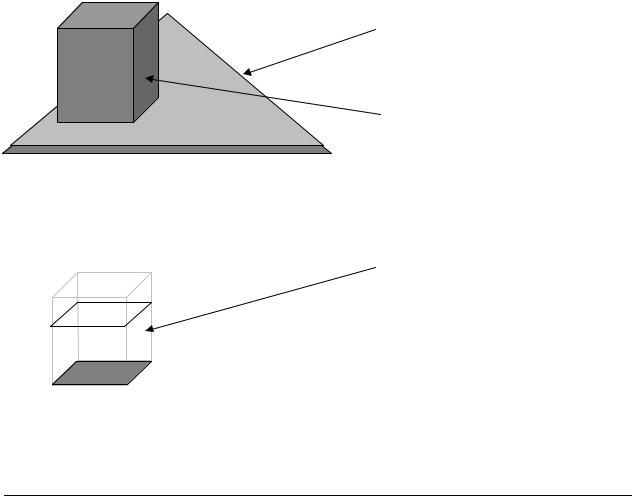
- •About the MPRs
- •How to Submit Questions about the MPRs
- •If MPR Compliance is Called into Question
- •Dealing with Prohibitive Characteristics Not Addressed by the MPRs
- •Dealing with Building Types Not Specifically Accommodated for in the LEED Rating Systems
- •How to Select a Rating System
- •How to Document Compliance with the MPRs
- •How to Deal with Multiple Buildings / Spaces Situations
- •Attached Buildings

11
2. MUST BE A COMPLETE, PERMANENT BUILDING OR SPACE
All Rating Systems:
All LEED projects must be designed for, constructed on, and operated on a permanent location on already existing land. LEED projects shall not consist of mobile structures, equipment, or vehicles. No building or space that is designed to move at any point in its lifetime may pursue LEED Certification.
New Construction, Core & Shell:
LEED projects must include the new, ground-up design and construction, or major renovation, of at least one commercial, institutional, or high-rise residential building in its entirety.
Commercial Interiors:
The LEED project scope must include a complete interior space distinct from other spaces within the same building with regards to at least one of the following characteristics: ownership, management, lease, or party wall separation.
Existing Buildings: O&M:
LEED projects must include at least one existing commercial, institutional, or high-rise residential building in its entirety.
INTENT:
The LEED rating systems were designed to evaluate complete buildings and spaces in fixed locations. Partial buildings or spaces are unsuitable for LEED certification because when analyzed under the requirements of LEED prerequisites and credits, they create results inconsistent with those of whole buildings or spaces. Also, partial certification can easily appear to encompass an entire building or space, sending a false message to the occupants.
Permanency is important because a significant percentage of LEED prerequisites and credits are dependent on location, making a mobile building or space unacceptable. The stipulation for already existing land responds to the fact that artificial land masses displace and disrupt aquatic ecosystems. Buildings that generate the need to develop such land do not meet the overall intent of the LEED rating system. Anything less than a distinct, complete, and permanent project on existing land will not be able to accurately demonstrate compliance with LEED.
SPECIFIC ALLOWED EXCEPTIONS:
Attached Buildings
MPR#2 requires a LEED project to be a building in its entirety for use of all but the Commercial Interiors Rating Systems. This section allows for buildings (such as additions) that do not meet the definition of entirety to comply with MPR#2 if certain conditions are met. The conditions listed below are written to prevent two kinds of problems that attached buildings can lead to: 1) compromised technical integrity of LEED certification and 2) misperception of certification boundaries.
CaGBC Minimum Program Requirements (MPRs)
Released: July 31, 2012
© 2012 Canada Green Building Council

12
This section lists conditions and guidance in three parts. All attached buildings should comply with part I, and those buildings attached to buildings that are already LEED-certified should comply with part II; whereas those attached to buildings that are not already LEED-certified should comply with part III.
I. ALL attached buildings
II. Buildings attached to LEED certified buildings
III. Buildings attached to non LEED certified buildings
I.ALL ATTACHED BUILDINGS
1.DRAWING A PROJECT BOUNDARY
The majority of the certifying floor area vs. the non-certifying floor area is often clear, as a result of construction, ownership, management, or space usage type boundaries. Often, one or more of the following occurs, making it difficult to draw the exact line of the LEED project boundary:
1.Minor construction work is occurring outside of the area intended to be LEED certified
2.Circulation space serves several attached buildings
3.New core mechanical systems that serve several attached buildings are being installed
Project teams must use their own judgment to make reasonable decisions about these situations on a case by case basis. Generally, construction work or space that serves buildings other than the one certifying should be excluded from the LEED project boundary. Note that construction work extending into non-certifying area must be consistently excluded from the certification process.
See guidance under MPR #3 for more information on determining the LEED project boundary in terms of surrounding land.
2.TREATING ENERGY SYSTEMS
For prerequisites and credits that deal with mechanical systems, the project team has three choices:
a)Separate systems
Mechanical systems are completely separate from those in the existing building (emergency generators excepted) and can be modelled separately.
b) Shared central systems located outside of the structures in question
LEED Canada 2009 Interpretation Guide for District Energy Systems, available at www.cagbc.org under the applicable rating system page explains how to create an energy model in this situation.
c)Shared central systems located inside the structures in question
LEED Canada-CI EAc1.3 Option B gives guidance on modelling the entire addition and all systems serving the addition. However, projects must use the version of the ASHRAE or MNECB standard applicable to their rating system.
3.CHOOSING A RATING SYSTEM
The certifying gross floor area, and only that area, should be used to determine which rating system is appropriate. Guidance on individual rating systems is provided in the introductions to the reference guides.
CaGBC Minimum Program Requirements (MPRs)
Released: July 31, 2012
© 2012 Canada Green Building Council

13
4.ALLOWING FOR A SMOOTH REVIEW
The documentation of the certifying project must not create technical barriers to the completion of the certification review. It is incumbent upon the project team to ensure the following:
a)The distinction between the certifying and non-certifying gross floor area (in particular, the LEED project boundary) is clearly delineated on all relevant documents.
b)All building components of the LEED project that are addressed by LEED prerequisites and pursued credits (systems, materials, etc) are separate or separable for the purposes of the LEED review, from the building to which it is attached.
5.The LEED project, as defined by the LEED project boundary, must meet all MPR, prerequisite, and credit requirements independent of any building it may be attached to.
6.The certifying gross floor area must be contiguous. Multiple floors are acceptable, but noncertifying floors between certifying floors are not.
NOTE: please see sections further below for multiple floor exceptions.
7.Fire safety infrastructure such as sprinklers, stairwells, and alarm systems may be shared with the non-certifying building.
8.LEED Canada EB: O&M project teams are encouraged to carefully review the requirements for EA Prerequisite 2 and Credit 1: Minimum/Optimize Energy Efficiency Performance before registering an attached building.
II.BUILDINGS ATTACHED TO LEED CERTIFIED BUILDINGS
If a wing or tower is connected to a building that is already LEED certified, the addition/attached building may be considered a separate building for LEED purposes if the following conditions are met.
1.RESTRICTION ON RATING SYSTEMS
The existing, previously certified building may have been certified under any version of one of the following rating systems.
Either the CaGBC or USGBC versions of:
•Existing Buildings: Operations & Maintenance (EB:O&M)
•New Construction & Major Renovations (NC)
•Core & Shell Developments (CS)
•Commercial Interiors (CI) (ONLY if at least 90% of the existing building’s total gross floor area was certified)
The USGBC versions of:
•LEED for Schools
•LEED for Healthcare
•LEED for Retail: NC
•LEED for Retail: CI (ONLY if at least 90% of the existing building’s total gross floor area was certified)
CaGBC Minimum Program Requirements (MPRs)
Released: July 31, 2012
© 2012 Canada Green Building Council

14
The currently certifying attached building should use a design and construction whole building rating system.
2.PREVIOUS LEED CERTIFICATION
All buildings physically attached to the building currently pursuing certification must already be LEED certified. In the plan view below, this exception applies to Addition A in relation to the main building ONLY– the project team would need to meet the conditions listed for buildings attached to non-LEED certified buildings for the Wing A/Wing B connection:
|
Addition A |
Addition B |
Certified main building |
III.BUILDINGS ATTACHED TO NON LEED CERTIFIED BUILDINGS
1.VERTICALLY ATTACHED, LEED Canada EB:O&M, AND MAJOR RENOVATION PROJECTS If the certifying project is certifying under LEED Canada EB: O&M OR is a major renovation
AND/OR is vertically attached to the non-certifying building, then it must be separated from the attached building by the following:
a)Ownership AND
b)Management OR space usage type
2.SEPARATE NAME
A separate name (including, if a horizontally attached project, a word such as ‘addition’, or ‘wing’ that indicates a physical difference) must be given to the certifying building. The same name must be used for all purposes – title of the LEED project as registered with the CaGBC, in formal publications, internal and external property listings and databases, signage, etc.
3.ACCURATE LEED REPRESENTATION
LEED certification must be accurately communicated to building users. All promotional and descriptive material produced by the owner or on the owner’s behalf clearly distinguish the LEED certified building from any other that it is attached to. This includes clearly marking the distinction between the two spaces with signage. Alternatively, if the LEED certification of the building is confidential, the project team may opt to not communicate the achievement of LEED certification. In this situation, no signage, marketing, or publicity of any kind would announce the LEED certification.
4.VERTICALLY ATTACHED BUILDINGS ONLY: 20% OF THE TOTAL GROSS FLOOR AREA REQUIRED
The certifying gross floor area must include at least 20% of the gross floor area of the overall structure. If the entirety of the certifying project OR the entirety of the non-certifying gross floor area is public infrastructure (such as a subway station) then this rule does not apply.
5.VERTICALLY ATTACHED BUILDINGS ONLY: METERS REQUIRED TO BE SEPARATE
a)Energy usage meter - Every energy source servicing the building must be separately metered (emergency generators excepted).
b)Water usage meter
CaGBC Minimum Program Requirements (MPRs)
Released: July 31, 2012
© 2012 Canada Green Building Council

15
The definitions of vertically and horizontally attached buildings are further illustrated below.
|
|
|
|
|
|
|
|
|
|
|
|
|
|
|
|
|
|
|
|
|
|
|
|
|
|
|
|
|
|
|
|
|
|
|
|
|
|
|
|
|
|
|
|
|
|
|
|
|
|
|
|
|
|
Vertically attached buildings |
Horizontally attached buildings |
|||||||
•Previously developed support structures and artificial land mass
oBuildings located on previously constructed docks, piers, jetties, infill, and other manufactured structures in or above water are permissible, provided that artificial land is previously developed
(i.e., the land once supported another building or hardscape constructed for a purpose other than the development of the LEED project).
o Buildings cantilevered over water, highways, or other bodies are acceptable.
oExisting dry land (i.e., not wetlands) to which soil or other material has been added complies with this MPR.
•10% exemption for multitenant buildings certifying under LEED Canada EB: O&M
Multi-tenant buildings certifying under LEED Canada EB:O&M may exclude up to 10% of the gross floor area from some prerequisites and credits as outlined in the LEED Canada EB:O&M Reference Guide and its LEED Letter Templates.
•Construction scope that may be excluded from a LEED Canada CI project boundary
Sometimes elements of the exterior shell, primary structural components, or core mechanical systems that are being renovated or installed in parallel to the interior fit-out or alteration make up the bulk of the LEED project. Spaces containing these elements may be excluded from the LEED project space if those elements are not under the control of the entity conducting the interior fit-out or alteration.
The line between certifying floor area and non-certifying floor area is not always clear. Project teams must use their own judgment to make reasonable decisions about these situations on a case by case basis. Generally, construction work or space that serves spaces other than the one certifying may be excluded from the LEED project boundary. Note that construction work extending into non-certifying area must be consistently excluded from the certification process.
•Understanding “complete interior space”
Basic Definition
For commercial interiors projects, this MPR states:
“The LEED project scope must include a complete interior space distinct from other spaces within the same building with regards to at least one of the following characteristics: ownership, management, lease, or party wall separation.”
The glossary gives the definition of ‘complete interior space’ as “At a minimum, all the gross floor area within the exterior walls of a building that is within a single occupant’s control and contains all building components altered as part of the same construction scope.” In addition to those attributes listed above,
CaGBC Minimum Program Requirements (MPRs)
Released: July 31, 2012
© 2012 Canada Green Building Council

16
floors can be used to distinguish a complete interior space, if one floor is unaffected by construction work. This is illustrated below.
This is a section drawing of a three story office building, all under the same ownership and management
Scenario 1: only the third floor is undergoing construction (shaded), so it can be considered a complete interior space by itself, and the LEED project boundary will be limited to that floor.
Scenario 2: Both the second and third floors are undergoing construction, so one floor by itself cannot be considered a complete interior space. They both must be included within the LEED project boundary.
Exceptions
There are many situations in which a single entity owns, manages, and/or occupies an entire building, and wishes to certify a renovated portion of the building that is not separate from other portions by one of the attributes listed above.
•Part of one floor-
•Multiple, non contiguous parts of one floor-
•Multiple certifying floors separated by non certifying floors
For example, multiple unconnected office spaces within a warehouse may be renovated, but not the main warehouse floor area. In the section drawing of an academic science building below, only the labs (shaded) on the first and third floors are undergoing an alteration:
Such spaces are not automatically disqualified from attempting to certify under LEED Canada CI. Project teams with this situation must submit a narrative in their certification submission confirming that the conditions below are met. The narrative should include (or reference) drawings, photos and other supporting material to justify compliance with the conditions, where necessary.
a)It is unreasonable or impossible to draw a project boundary where there is separation by ownership, management, lease, or party wall separation. This often happens when the edge of the construction work does not coincide with such a boundary.
b)The construction work is being conducted under a single contract.
c)The project boundary includes 100% of the construction scope (it may extend beyond the construction scope. However, at least 60% of the total certifying gross floor area must be undergoing alteration).
d)The LEED project boundary is drawn at a clear functional AND physical barrier.
CaGBC Minimum Program Requirements (MPRs)
Released: July 31, 2012
© 2012 Canada Green Building Council

17
e)Signage will be provided to clearly demarcate the LEED space.
f)The LEED project boundary is not drawn in such a way as to create an unreasonably difficult review process that results from the reviewer’s inability to distinguish between strategies, services, or materials in the LEED certifying space and the non-LEED certifying space. For example, it would be best if the LEED project boundary coincided with an HVAC zone boundary.
ADDITIONAL INFORMATION AND CLARIFICATION
•Ensuring compliance with the ‘entirety’ requirement
For whole building rating systems (all but LEED Canada CI), this MPR states:
“LEED projects must include the new, ground up design and construction, or major renovation, of at least one commercial, institutional, or high rise residential building in its entirety.”
In the glossary, relevant definitions include:
o |
Entirety |
o |
Physically distinct |
o |
Party wall |
o |
Major renovation |
Relevant additional guidance includes:
oThe attached buildings guidance above, which defines exceptions for horizontally and vertically connected buildings
•The “already existing land” requirement is applicable to the entire LEED project
This MPR requires that “All LEED projects must be designed for, constructed on, and operated on a permanent location on already existing land.” This requirement is applicable to all land within the LEED project boundary.
•How to treat parking garages
Parking garages may not earn LEED certification
Parking garages for cars and trucks may not pursue LEED certification. More specifically, buildings that dedicate more than 75% of floor area to the storage and circulation of cars and/or trucks are ineligible for LEED. Floor area should be considered even if it is not covered, enclosed, or conditioned. This clarification does NOT apply to vehicle maintenance shops of any kind, airport hangers, border facilities, car salesrooms, transit centers, or other buildings that deal with cars and trucks in a capacity other than parking, OR with vehicles other than cars and trucks.
Parking garages may not be included in the gross floor area of the LEED project building
The definition of gross floor area in the glossary specifically disallows the inclusion of parking.
Parking garages may be included within the LEED project boundary
CaGBC Minimum Program Requirements (MPRs)
Released: July 31, 2012
© 2012 Canada Green Building Council

18
If parking is within, connected to, or on the site of the LEED project building, it may be (and sometimes, must be) included within the LEED project boundary. The MPR #3 section gives more guidance on this issue.
•Modular buildings elements are allowed
Prefabricated or modular structures and building elements of any variation may be certified once permanently installed and/or established as part of the LEED project building in the location that they are intended to stay for the life of the entire structure.
•Buildings with movable parts are allowed
Large movable parts, such as a retracting ceiling in a stadium, do not violate this MPR.
•Movable buildings are prohibited
oStructures not compliant with this MPR include cars, motor homes, trains, boats, ships, planes, and transient exhibits of any kind.
oIf, for any reason, a LEED Canada 2009 certified building is moved from the location cited at the time of LEED certification, it will no longer be in compliance with this MPR and the certification will become invalid.
•Special considerations for commercial interiors projects
MOBILITY
Buildings in which commercial interiors projects are located must be immobile, and are subject to the same guidance on the subject of permanency as projects that are certifying under whole building rating systems.
ALREADY EXISTING LAND
Buildings in which commercial interiors projects are located are NOT required to be built on already existing land.
•Planned obsolescence
While the CaGBC does not encourage planned obsolescence, the amount of time that a building or space is intended to remain standing does not affect compliance with this MPR. The purpose is to disallow a project to certify a structure that is intended to be mobile over the course of its lifetime.
• Multi-party ownership
Multiple party ownership of a certifying building or space is acceptable. Proper accountability for MPR and rating system conformance must be in place.
•No exceptions for projects with EQp2 conflicts
Some project buildings, such as casinos, typically have difficulty achieving LEED certification due to a smoking policy that conflicts with Indoor Environmental Quality prerequisite 2, Environmental Tobacco Smoke Control (EQp2). There will be no exceptions to this MPR to allow for partial building certification of such buildings. Project teams are encouraged to carefully review option 2 in EQp2 to explore opportunities to achieve LEED certification despite a smoking room located within a project.
CaGBC Minimum Program Requirements (MPRs)
Released: July 31, 2012
© 2012 Canada Green Building Council

19
•Multiple buildings
This MPR states that “LEED projects must include the new, ground-up design and construction, or major renovation, of at least one….building in its entirety”, thus, a LEED project may only include ONE building unless the project qualifies for a multiple building submission. Currently this multiple building path is available to LEED Canada NC 2009 and LEED Canada CS 2009 projects as outlined in the Introduction to the LEED Canada Reference Guide for Green Building Design and Construction 2009. A multiple space path is outlined in Multiple Space Guidance for LEED Canada for Commercial Interiors v1.0, available on CaGBC’s website. It is planned that similar guidance for a multiple building pathway for LEED Canada EB:O&M 2009 will be released Fall/Winter 2012.
•Defining ‘one building’
Super-structures can often be perceived as either a string of multiple buildings, or as a single building. This is typically due to light physical connections, such as a single hallway between buildings that are otherwise physically distinct. Such super-structures may, for the purposes of LEED, be considered a single building if both of the following criteria are met.
a)Space that can be included in the gross floor area of the project that serves a purpose other than parking or the circulation of people is contiguous throughout the structure.
b)All building components of the LEED project that are addressed by LEED prerequisites and pursued credits (systems, materials, etc) can be treated as one, such that separate reviews of the same issues are not required for different portions of the superstructure.
If these criteria are not met, the project may be considered a set of multiple buildings, regardless of whether or not it can satisfy the ‘attached building’ criteria as noted in the earlier sections above.
• LEED for Core & Shell projects and ‘entirety’
For a project certifying under LEED Canada CS, the project is considered a ‘building in its entirety’ without interior fit outs complete.
CaGBC Minimum Program Requirements (MPRs)
Released: July 31, 2012
© 2012 Canada Green Building Council

20
3. MUST USE A REASONABLE SITE BOUNDARY
New Construction, Core and Shell, Existing Buildings: Operations and Maintenance
1.The LEED project boundary must include all contiguous land that is associated with and supports normal building operations for the LEED project building, including all land that was or will be disturbed for the purpose of undertaking the LEED project.
2.The LEED project boundary may not include land that is owned by a party other than that which owns the
LEED project unless that land is associated with and supports normal building operations for the LEED project building.
3.LEED projects located on a campus must have project boundaries such that if all the buildings on campus become LEED certified, then 100% of the gross land area on the campus would be included within a LEED boundary. If this requirement is in conflict with MPR #7, Must Comply with Minimum Building Area to Site Area Ratio, then MPR #7 will take precedence.
4.Any given parcel of real property may only be attributed to a single LEED project building.
5.Gerrymandering of a LEED project boundary is prohibited: the boundary may not unreasonably exclude sections of land to create boundaries in unreasonable shapes for the sole purpose of complying with prerequisites or credits.
Commercial Interiors
If any land was or will be disturbed for the purpose of undertaking the LEED project, then that land must be included within the LEED project boundary.
INTENT:
In order to ensure fair and consistent evaluation for all projects |
|
particularly under the Sustainable Sites credit |
||||
category |
|
it is necessary to have guidelines for an acceptable |
LEED project boundary. All site conditions and |
|||
|
|
– |
|
|||
|
related to a building must be considered and addressed in the certification process to ensure a complete |
|||||
impacts |
|
– |
|
|
|
|
and thorough examination of the environmental impact of a building.
SPECIFIC ALLOWED EXCEPTIONS:
•Land assigned to previous projects may be re-assigned to EB: O&M projects
Any land associated with a previous LEED project (NC or CS) may be re-assigned to a LEED Canada EB:O&M project with no restrictions.
• When non-contiguous parcels may be included in the LEED project boundary
Non contiguous parcels of land may be included within the LEED project boundary if the conditions below are met.
a)The parcel(s) where the LEED project building resides is separated by land that is owned or controlled by an entity different than the owner of the land associated with the LEED project building (e.g. a public right-of-way through the site controlled by the city).
CaGBC Minimum Program Requirements (MPRs)
Released: July 31, 2012
© 2012 Canada Green Building Council

21
b)Those parcels separated from the parcel on which the LEED building resides directly supports or are associated with normal building operations of the LEED building. See additional guidance on the following page of this document.
c)The non-contiguous parcels are no more than ¼ mile (0.40 kilometer) walking distance apart.
d)There is a clear and safe walking path between the parcels.
e)In aggregate, the parcels meet the requirements of all MPRs, prerequisites, and attempted credits.
f)All parcels share the same common regulatory jurisdiction and are owned, leased, or managed by the same organizational entity.
g)The project team provides a narrative and a map to demonstrate compliance with items (a) through (f) above.
•When land included in submittals may be excluded from the LEED project boundary
Land described in this section is not required to be included in the LEED project boundary, and therefore is not subject to consideration for prerequisite, other credit, or other MPR compliance.
ALL RATING SYSTEMS: STORM WATER DESIGN CREDITS
Any land used solely to earn this credit, but not otherwise required to be included by MPR #3.
LEED CANADA EB: O&M, SUSTAINABLE SITES CREDIT 5 SITE DEVELOPMENT-PROTECT OR RESTORE HABITAT
Any land used solely to earn this credit, but not otherwise required to be included by MPR #3.
•When facilities included in submittals may be excluded from the LEED project boundary
Occasionally, project buildings use facilities (e.g. parking lots) that are outside of the LEED project boundary as part of their calculations for the parking, bicycle storage, shower/changing rooms, and/or onsite renewable energy credits. This is allowable when the facilities serve the LEED project, and at least one of the following two conditions is met:
a)The facilities are not a part of the LEED project construction scope.
b)The facilities are physically separate from the LEED project by land not owned by the LEED project owner (or, if on a campus, physically separate such that the inclusion of the facilities in the LEED project boundary would be difficult or unreasonable).
If the facilities meet one of these conditions, they may be excluded from the LEED project boundary, and therefore they will not be considered for other prerequisite, credit, or MPR compliance. However, those facilities also cannot be used to show compliance for other LEED projects, unless the sufficient capacity is present.
EXAMPLE
There are showers in a building adjacent to the LEED project building. The showers may be excluded from the LEED project boundary even if they are used to show compliance with Sustainable Sites credit 4.2: Alternative Transportation, Bicycle Storage and Changing Rooms in LEED Canada NC, but they may not be included in the calculations for Water Efficiency
CaGBC Minimum Program Requirements (MPRs)
Released: July 31, 2012
© 2012 Canada Green Building Council

22
prerequisite 1. In addition, the showers cannot be used to earn this credit for an additional LEED project unless the required shower-to-Full Time Equivalent (FTE) ratio is met for both projects.
•Real property no longer attributed to a certified building
If a certified building is demolished, all property attributed to that LEED project may be assigned to another LEED project.
•When land not owned by the LEED project owner may be included
Land that the LEED project owner does not own (i.e., leases, has an easement on, or has no claim to) would generally not be included within the LEED project boundary. However, it can be included if it can very clearly be shown to support building functions (this includes stormwater management strategies) or is a part of the construction scope.
•Project boundaries that include other buildings
There are many situations in which it is appropriate for the LEED project boundary to include another building. These include:
oAn addition to an existing building, when the entire structure is surrounded by land that supports the addition and therefore could be included within the LEED project boundary.
o The site of the LEED project includes several smaller, supporting buildings.
In such cases, the LEED rating will only officially apply to the project building, although the ancillary structures (other buildings) may have to be accounted for in the calculations for the LEED project. The following guidance addresses these situations, breaking them into two categories: 1) LEED-certifiable building on site and 2) not LEED-certifiable building on site.
LEED-CERTIFIABLE BUILDING ON SITE
If there is another LEED-certifiable building on the same site as the LEED project building, it is not required to certify, but in order to take credit for aspects of the site that are shared between the buildings, LEED Canada NC and LEED Canada CS project(s) should refer to the campus direction in the LEED Canada Reference Guide for Green Building Design & Construction 2009. The direction in the Introduction, page xxi, and under related site credits, allows for all site attributes to contribute to LEED certification by the use of shared campus credit strategies. Note that this guidance can be applied to vertically attached buildings, in which case the master site boundary and the individual site boundaries can coincide on all edges. Campus guidance is only available to LEED Canada NC and LEED Canada CS projects at this time.
NON-LEED-CERTIFIABLE BUILDING ON SITE
If there is a non-LEED-certifiable building within the LEED project boundary, the project team can include the non-certifying building within the project boundary. In this case, the applicant must include the non-certifying building in ALL relevant credits and prerequisites, essentially treating the non-certifying building as an extension of the certifying building.
•Temporary structures
Temporary structures erected for the purposes of supporting construction administration work that will be removed at construction completion are not subject to this MPR and will not be required to certify.
CaGBC Minimum Program Requirements (MPRs)
Released: July 31, 2012
© 2012 Canada Green Building Council

23
ADDITIONAL INFORMATION AND CLARIFICATIONS
•How to define land that is associated with and directly supports a building
This MPR requires that ‘The LEED project boundary must include all contiguous land that is associated with and supports normal building operations for the LEED project building...’. This includes land altered in any way as a result of the LEED project construction, with exceptions as detailed above, and features enjoyed primarily by the building users, such as:
•Hardscape, such as parking and sidewalks
•Septic treatment equipment
•Stormwater treatment equipment
•Landscaping
Often, land is shared with other buildings, extends into large areas of land, or has other attributes such that it is unclear where the project boundary should be drawn. Although many of these situations are addressed in this document, there will always be unique circumstances that cannot be anticipated. In this case, it is the responsibility of the project team to determine a reasonable boundary that meets the intent of LEED and the available guidance as much possible.
EXAMPLE
Two neighboring stores are being constructed, and one is pursuing LEED certification. A new parking lot with fifty spaces will be shared by the two stores. The certifying store calculates that it requires the use of twenty parking spaces on a regular basis to serve its employees and customers. Therefore, the project team must draw its LEED project boundary to include twenty spaces and forty percent (20/50 = 40%) of the supporting hardscape (driveways, sidewalks, etc).
EXAMPLE
A construction project on a college campus will result in a new student center and a new stormwater infrastructure, including drainage pipes and a retention pond. The infrastructure will serve the new building as well as other buildings on campus. It is at the project team’s discretion to include this infrastructure in their LEED project boundary or not. However, if it is included it must be included consistently for all applicable prerequisites and attempted credits.
•Understanding gerrymandering
Gerrymandering is defined in the document’s glossary below as ‘To divide and assign land in such a way as to give unfair, inconsistent representation to one parcel over another.’ Gerrymandering can also be described as the exclusion of site area from the LEED Project Boundary that is associated with or directly supports building functions in order to achieve a LEED prerequisite or credit.
CaGBC Minimum Program Requirements (MPRs)
Released: July 31, 2012
© 2012 Canada Green Building Council

24
4. MUST COMPLY WITH MINIMUM FLOOR AREA REQUIREMENTS.
New Construction, Core and Shell, Existing Buildings: Operations and Maintenance
The LEED project must include a minimum of 1,000 square feet (93 square meters) of gross floor area.
Commercial Interiors
The LEED project must include a minimum of 250 square feet (22 square meters) of gross floor area.
INTENT:
The thresholds and calculations that make up the system of evaluation in LEED begin to break down and lose meaning once the building or space being evaluated reaches relatively diminutive proportions.
SPECIFIC ALLOWED EXCEPTIONS
None
ADDITIONAL INFORMATION AND CLARIFICATIONS
•Specific building type guidance
Open air stadiums, kiosks, and similar building types satisfy this MPR if the minimum required amount of gross floor area is met for some part of the structure. The definition of gross floor area must be carefully reviewed when considering such a building for compliance with this MPR.
CaGBC Minimum Program Requirements (MPRs)
Released: July 31, 2012
© 2012 Canada Green Building Council

25
5. MUST COMPLY WITH MINIMUM OCCUPANCY RATES
All rating systems
Full Time Equivalent Occupancy
The LEED project must serve 1 or more Full Time Equivalent (FTE) occupant(s), calculated as an annual average in order to use LEED in its entirety. If the project serves less than 1 annualized FTE, optional credits from the Indoor Environmental Quality category may not be earned (the prerequisites must still be earned).
Additionally, for Existing Buildings: O&M:
Minimum Occupancy Rate
The LEED project must be in a state of typical physical occupancy, and all building systems must be operating at a capacity necessary to serve the current occupants, for a period that includes all performance periods as well as at least the 12 continuous months immediately preceding the first submission for a review.
INTENT:
Many prerequisites and credits throughout the LEED rating systems evaluate the impact of the LEED project building on the building users, particularly those prerequisites and credits in the IEQ credit category. It is therefore appropriate and necessary to require that a minimum number of people benefit from the strategies implemented in a LEED project building in order to earn any credits.
In LEED Canada EB: O&M, compliance with many prerequisites and credits is evaluated based on actual usage patterns. Therefore, it is necessary to require that typical usage of the LEED project building is underway during the performance periods, so that accurate measurements can be taken.
SPECIFIC ALLOWED EXCEPTIONS
MINIMUM OCCUPANCY RATE APPLICABLE TO LEED CANADA EB:O&M ONLY
•Unexpected and temporary decline in occupancy
If occupancy unexpectedly and temporarily falls below the required threshold within the period of time subject to this MPR11, but still meets the requirement using a weighted average (as described below), the project team must submit a description of the situation as well as the measures they have taken to keep the reduced occupancy numbers from affecting the results for each prerequisite and credit that deals with occupancy. Explanations specific to a prerequisite or credit should be given in the certification submission for each prerequisite and credit impacted, as well as a general description in the overall narrative.
Any building that experiences occupancy of less than 100% during a performance period should refer to the Reduced Occupancy Guidance for LEED Canada EB:O&M located on the LEED Canada EB: O&M rating system page at www.cagbc.org when completing submittal requirements.
1 As stated in the MPR language, the period of time subject to this MPR includes at least the 12 continuous months immediately preceding the first submission for a review and all performance periods.
CaGBC Minimum Program Requirements (MPRs)
Released: July 31, 2012
© 2012 Canada Green Building Council

26
•Determining compliance with fluctuating occupancy rates
All buildings, except for hotels, are considered to be in compliance with this MPR if more than 50% of its floor area is fully occupied (e.g., in a state of typical physical occupancy). This should be time-averaged over the performance period for all prerequisites and attempted credits, including the 12 months leading up to the initial submittal of application for review. The threshold for hotels is 55%.
EXAMPLE
A hotel has 100 equally sized rooms and no common space aside from a small lobby. Since the hotel was built, sixty of the rooms have been full as an annual average, taking into account all seasons. Therefore, it is considered to be in compliance with this MPR because sixty percent (60/100 = 60%) exceeds the minimum threshold of 55%.
EXAMPLE
There is a school with nine equally sized classrooms and circulation space equal to the floor area of one classroom. Four of the classrooms are not being used, but the other five are being fully used. Therefore, occupancy for the entire building is at sixty percent (5+1/10 = 60%). If attendance in three of the classrooms drops to 50% each, then occupancy for the entire building drops to 45%, and compliance with this MPR is in question.
The following formula may be used for more precise calculations in determining compliance:
[ (number of days at x% capacity * x%) + (number of days at y% capacity * y%) + ( … ) ] / total days in operation
EXAMPLE
An office building with ten equally sized floors submits for preliminary review on January 1; exactly a year after its earliest performance period began. It is open 260 days a year. The building operated at full capacity for the first 150 work days of that year. Unexpectedly, six floors become vacant (occupancy drops to 40%) for 50 days. Then, those six floors become occupied again, each operating at half its capacity for the last 60 days (occupancy for the entire building rises to 60%).
[ (150*1) + (50*.4) + (60*.6) ] / 260 = 79%
Because offices are required to be at 50% capacity at a minimum, this building is in compliance with this MPR.
ADDITIONAL INFORMATION AND CLARIFICATIONS
FULL TIME EQUIVALENT OCCUPANCY APPLICABLE TO ALL RATING SYSTEMS
•Calculation method for determining annual FTE in design and construction projects
Although each building varies in regular occupancy, the purpose of setting the baseline annual FTE is to ensure sufficient occupancy to warrant awarding points in the IEQ credit category.
Annual FTE is based on the average 40 hour work week, assuming 48 total work weeks in the year. Based on this assumption, one annual FTE is defined as one person spending eight hours a day for 240 days in the building, or 1920 hours annually. The calculation can be done by average FTE occupants per day, week, or month:
CaGBC Minimum Program Requirements (MPRs)
Released: July 31, 2012
© 2012 Canada Green Building Council

27
By day, must be greater than or equal to 240: (total occupant hours in an average day/8) x number of occupied days
By week, must be greater than or equal to 48: (total occupant hours in an average week/40) x number of occupied weeks
By month, must be greater than or equal to 12: (total occupant hours in an average month/160) x number of occupied months
EXAMPLE
A religious worship facility has an hour-long service once a week for a year, and an average of thirty people attends each service. The building stands empty the remainder of the time. The annual FTE calculation for this building is:
(30 total occupant hours in an average day / 8) x 52 occupied days = 195
Therefore, the combined occupant (employee, staff, student, visitor) hours result in the equivalent of one person spending 195 eight hour days in the facility. IEQ credits may not be pursued. However, if it gains 10 new members, this MPR would be satisfied:
(40 total occupant hours in an average day / 8) x 52 occupied days = 260
•Only occupant hours that the building expects to accommodate under normal building operations shall be included in annual FTE calculations. The project team must make a reasonable projected estimate when determining FTE.
•For projects using rating systems other than LEED Canada EB: O&M, the projected date of full occupancy is irrelevant.
MINIMUM OCCUPANCY RATE APPLICABLE TO LEED CANADA EB:&OM ONLY
•Space types subject to this MPR
Gross floor area that is designed to be regularly occupied should be the focus when determining compliance with this MPR.
Any common space such as a lobby or bathroom that receives regular use, as well as any space that does not typically have occupants (such as closets or mechanical rooms) counts toward compliance with this MPR. Common space that is not receiving any use (e.g., a bathroom on a floor completely devoid of occupants) does not count toward compliance.
•Determining typical physical occupancy
The definition of typical physical occupancy is ‘The state in which normal building operations are underway and the building is in use by the average number of FTE occupants for which it was designed.’
To determine the average number of FTE occupants the building was designed for, project teams must assess buildings on a case by case basis, using reasonable judgment. Design intentions, floor area capacity, and building system capacity must all be considered. Atypical or indeterminate cases must be described in the overview narrative during certification submission.
CaGBC Minimum Program Requirements (MPRs)
Released: July 31, 2012
© 2012 Canada Green Building Council

28
Space is considered occupied based on actual usage, NOT leasing. Leased space is only considered occupied if it is physically occupied.
CaGBC Minimum Program Requirements (MPRs)
Released: July 31, 2012
© 2012 Canada Green Building Council

29
6.MUST COMMIT TO SHARING WHOLEBUILDING ENERGY AND WATER USAGE DATA
At this time, the CaGBC does not require projects to provide the CaGBC with access to actual whole building energy and water usage data except where necessary to meet the requirements of the credits for LEED Canada EB:O&M. However, the CaGBC recognizes that Measurement and Verification (M&V) are critical to the successful optimization of high-performance green buildings. In recognition of the merits of M&V, as well as the importance of better understanding how LEED buildings perform, Credit Interpretation Ruling (CIR) #876 outlines how LEED Canada NC and LEED Canada CS project teams may earn an Innovation and Design Process (ID) credit for participating in the CaGBC’ s GREEN UP program.
CaGBC Minimum Program Requirements (MPRs)
Released: July 31, 2012
© 2012 Canada Green Building Council

30
7. MUST COMPLY WITH A MINIMUM BUILDING AREA TO SITE AREA RATIO
The gross floor area of the LEED project building must be no less than 2% of the gross land area within the LEED project boundary.
INTENT:
Because LEED is a rating system for buildings, it is appropriate to restrict the amount of land associated with a LEED certified project.
SPECIFIC ALLOWED EXCEPTIONS
None
ADDITIONAL INFORMATION AND CLARIFICATIONS
•Calculation method for determining gross floor area to site area ratio
[ Gross Floor Area (m2) / Site Area (m2) ] x 100
EXAMPLE
A 400 square metre building is located on a 21,800 square metre site:
[400/ 21,800] x 100 = 1.8%
This building must claim only 20,000 square metres within its LEED project boundary to meet the 2% building area to site area minimum.
•There is no maximum ratio
There is no maximum building area to site area ratio.
•Addressing conflicts with MPR #3
If a LEED project boundary must be adjusted in order to meet this MPR, the adjustment must be done such that the new boundary also complies with MPR #3, Must Use a Reasonable Site Boundary. If there is a conflict, this MPR takes precedence. In other words, the project team may eliminate land that is usually required by MPR #3 to be within the project boundary, in order to comply with this MPR. However, the elimination must be done in a reasonable fashion; the project team cannot remove land specifically because it would not comply with another MPR, prerequisite, or credit requirement.
•Projects without land in the LEED project boundary comply by default
If there is not any land included within the LEED project boundary (as will typically be the case with LEED Canada CI projects), the project will be in compliance with this MPR by default.
CaGBC Minimum Program Requirements (MPRs)
Released: July 31, 2012
© 2012 Canada Green Building Council

31
• Treatment of land used with SSc5 Site Development –Protect or Restore Habitat in LEED Canada EB: O&M
Off site land used to earn Sustainable Sites credit 5 in LEED Canada EB: O&M must be included in the calculations for this MPR.
CaGBC Minimum Program Requirements (MPRs)
Released: July 31, 2012
© 2012 Canada Green Building Council

32
GLOSSARY
Alteration: Includes improvement work in addition to the rearrangement of any interior space by the construction of non-bearing walls, partitions, ceilings, and floors, the addition or elimination of any interior door or window, the extension or rearrangement of any mechanical, electrical, and plumbing (MEP) or service system (peripheral or core), and the installation of any additional equipment or fixtures. Work does not extend to the primary structural components, exterior shell, or roof of the building.
Certificate of Occupancy: A document issued by a local authority indicating that premises complies with provisions of zoning, building ordinances, building code, and/or approved plans and specifications. This is often required before premises can be occupied and title transferred.
Complete Interior Space: At a minimum, all the gross floor area within the exterior walls of a building that is within a single occupant’s control and contains all building components altered as part of the same construction scope. This is also referred to as the ‘completed design area’.
Contiguous: Touching, in contact.
Design and Construction Rating Systems: Any LEED rating system that addresses both the design and construction of a building or interior space. Includes LEED Canada for New Construction and Major Renovation, LEED Canada for Core & Shell, and LEED Canada for Commercial Interiors.
Entirety: The sum of the constructed components that make up a building which is physically distinct from another building.
Enclosed space: Floor area that is 100% separated (or separable with existing components) from outside space by walls, windows, and doors.
Exterior shell: Any part of a building structure that acts as a barrier between the interior and exterior.
Fit-out: See ‘interior fit-out’
Full Time Equivalent (FTE): A regular building occupant who spends 40 hours per week in the building or space, or the equivalent. Part-time or overtime occupants have FTE values based on their hours per day.
Gerrymander: To divide and assign land in such a way as to give unfair, inconsistent representation to one parcel over another.
Gross Floor Area: Equivalent to ‘Building Floor Area’ term used in LEED Canada rating systems. (Based on ASHRAE definition.) Sum of the floor areas of the spaces within the building, including basements, mezzanine and intermediate-floored tiers, and penthouses with headroom height of 7.5 ft (2.2 meters) or greater. Measurements must be taken from the exterior faces of exterior walls OR from the centerline of walls separating buildings, OR (for LEED Canada CI certifying spaces) from the centerline of walls separating spaces. Excludes nonenclosed (or non-enclosable) roofed-over areas such as exterior covered walkways, porches, terraces or steps, roof overhangs, and similar features. Excludes air shafts, pipe trenches, chimneys and floor area dedicated to the parking and circulation of motor vehicles.
NOTE: while excluded features may not be part of the gross floor area, and therefore technically not part of the LEED project building, they may still be required to be part of the overall LEED project and subject to MPRs, prerequisites, and credits.
Gross Land Area: Measure of the total amount of land within the LEED Project Boundary, including land under the footprint of the building. Also called ‘site area’.
Gross Square Feet/Square Metres: see ‘Gross floor area’.
Improvement: The restoration or application of interior finishes and fixtures, MEP and service system equipment repair/replacement/upgrades, minor space-use changes, and preventative or corrective maintenance.
CaGBC Minimum Program Requirements (MPRs)
Released: July 31, 2012
© 2012 Canada Green Building Council

33
Interior Fit-Out: The installation or application of interior finishes, floor and ceiling systems, non-bearing partitions, furniture, interior doors and windows, and other components that make a space fully usable for the purpose it is intended. A complete interior fit-out is such that no further construction work is needed or intended for occupancy.
Land: Any part of the earth’s surface not covered by a body of water.
LEED Project: All real property within the LEED project boundary, including the building(s) or space(s), all structures, land, etc. which collectively are attempting or have earned certification.
LEED Project Boundary: The line that indicates the limits of the real property for which the project team is attempting or has earned certification.
LEED Project Building: The structure which is attempting or has earned certification. LEED Project Space: The gross floor area which is attempting or has earned certification.
LEED Project Registration: The process through which the project team establishes a LEED project on CaGBC’s website. This process is considered complete once payment is received by CaGBC.
Major Renovation: Includes extensive alteration work in addition to work on the exterior shell of the building and/or primary structural components and/or the core and peripheral MEP and service systems and/or site work. Typically, the extent and nature of the work is such that the primary function space cannot be used for its intended purpose while the work is in progress and where a new certificate of occupancy is required before the work area can be reoccupied.
Normal Building Operations: The complete activities and functions intended to take place within the building and on associated property.
Operational Activities: See ‘Normal Building Operations’.
Parking: Area dedicated to the storage and movement of motor vehicles.
Party Wall: A wall without openings erected as a common support to structures on both sides.
Performance Period: The continuous, unbroken time during which sustainable operations performance for a building and/or site is being measured.
Physically Distinct: The condition in which a building has both of the following:
a)Exterior walls that are party walls or are separate from adjoining buildings by air space.
b)Lighting, HVAC, plumbing, and other mechanical systems that are separate from the systems of adjoining buildings.
LEED project boundary lines that “slice” through party walls must not pass through any MEP service infrastructure. Exceptions include buildings served by a common or shared chiller plant or heating water, or steam supply pipes (i.e., not air ducts), and only if the thermal energy serving the structure to be separated is sub-metered.
Primary Function Space: The floor area that serves the main purpose of the building or space.
Primary Structural Component: Any component of the load-bearing structure of a building including footings, piles, foundations, columns, girders, beams, joists, wind, or seismic bracing.
Project Work: See ‘Undertaking the LEED Project’.
Regularly occupied spaces: Areas where workers are seated or standing as they work inside a building. In residential applications, these areas are all spaces except bathrooms, utility areas, and closets or other storage rooms. In schools, they are areas where students, teachers, or administrators are seated or standing as they work or study inside a building.
Real Property: Land, and land alterations that are a direct result of human activities, that subsequently support an active land use, including structures of any kind.
CaGBC Minimum Program Requirements (MPRs)
Released: July 31, 2012
© 2012 Canada Green Building Council

34
Schematic Design: The initial phase of architectural work that establishes the scope and physical outline of the project.
Site Area: See ‘gross land area’.
Substantial Completion of Construction: The point at which work on the building project is sufficiently complete in accordance with all construction contract documents, and any strategies that the project is receiving recognition for under LEED are fully implemented, except for operations-related strategies (such as a thermal comfort survey).
Tenant Space: Please see ‘LEED Project Space’.
Typical Physical Occupancy: The state in which normal building operations are underway and the building is being used by the average number of full time equivalent occupants for which it was designed.
Undertaking the LEED Project: All design, construction, and development work that contribute to the creation of the LEED project building.
ILLUSTRATIONS OF COMMONLY USED TERMS
Typical situation for a project using a non-commercial interiors rating system:
The LEED project boundary
Everything within it is considered, collectively, the LEED Project.
The LEED Project Building. Within the building, all floor area that meets the definition of Gross Floor Area is considered the LEED Project Space.
Typical situation for a project using a commercial interiors rating system:
The LEED project boundary. Simultaneously, it is also the boundary of the LEED Project Space. Everything within it is considered, collectively, the LEED Project. Within it, all floor area that meets the definition of Gross Floor Area is considered the LEED Project Space.
CaGBC Minimum Program Requirements (MPRs)
Released: July 31, 2012
© 2012 Canada Green Building Council
